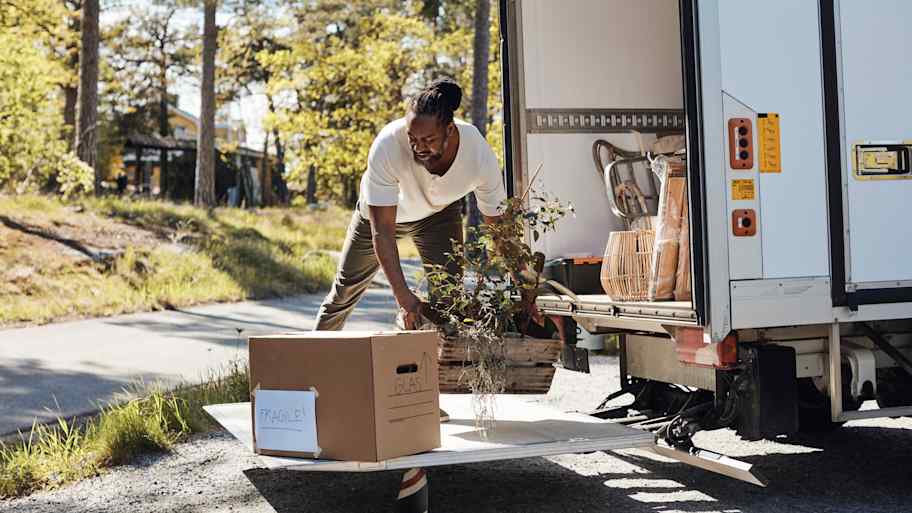
The cost range for renting a moving truck varies widely, so what can you expect to pay for your move? This cost guide breaks down all of the factors.
Don’t be nervous about packing your computer, we’ve got all the tips you need to ship it safely


It’s no wonder you’re concerned about packing your computer for your move—it’s a major lifeline to your home and work life. Whether you’re packing it to move with you in the car, pre-packing it for a local moving company to deliver, or packing it to ship it commercially, follow these six tips to ensure it arrives in the same condition you packed it.
Moving companies cannot legally sell “moving insurance.” Even though most people refer to it as moving insurance when they purchase it, its technical name is “moving coverage.” Only third-party insurance companies (like the national brands you see on TV) can sell moving insurance.
Using the original packing material and boxes is the best way to pack your computer, but don’t worry if you didn’t keep them; they’re easy to find. If you’re wondering where to find boxes, you can buy them at moving companies and hardware and home improvement stores.
Look for boxes that match the size of each of the main computer parts (monitor, tower, and accessories) and pack them separately. Pick boxes that are big enough to hold each piece, plus plenty of packing materials, but snug enough to restrict movement.
Dish-pack boxes are a good choice because they’re sturdy and designed to protect fragile items. If you have a small TV box, that’s a good option for your computer monitor.
Some people like double-boxing their computer parts, and it’s a viable option for shipping your computer. For example, you can pack your desktop tower in a sized-to-fit box inside a larger box filled with packing materials. When packing your computer, avoid using bubble wrap, which can cause static buildup that wreaks havoc on the hard drive and graphics card by damaging the computer chips.
You will also need the following packing supplies:
Packing paper or old towels to wrap the computer
Packing tape
Packing peanuts
Anti-static bubble wrap
We’ve all felt the waves of panic when something goes wrong with your computer, so ensure that you back up your computer’s contents before disassembling and packing it. Moving is a bumpy process; protect your computer from damage and data loss, so you’ll always have access to important documents and photos.
The good news is that there are a few free or inexpensive ways to store your information, including:
An external hard drive
A portable USB
A cloud storage service such as Google Drive, OneDrive, or Dropbox
Once you’ve backed up your computer, shut the machine down properly so you can expect an uneventful start-up later.
Taking the time to organize your computer and its accessories before boxing it up can ease the reconnection process. Use these helpful tips to make the unpacking process easier.
Take a trip to your local office supply store and buy colored dot stickers and matching colored Velcro cord wraps.
Before you unplug anything:
Neatly wrap each cord with a different color sticker
Label each corresponding input with a colored dot
Match the color of the sticker wrapped around the cord to the color of the input dot
For example, put a green dot next to your mouse input and place a matching green sticker wrap around your mouse cord. Always label the other end of each cord with the same color dot. When you’re unpacking, simply match the colors to make setting up your computer a snap.
It’s tempting to quickly unplug and pack everything up, but instead, photograph your computer set-up before you disconnect. Take several pictures at various angles. These photos will help you remember the correct assembly order later. You can even add notes and arrows onto your photos for extra help.
Before packing up, place a colored Velcro wrap around one end of each cord. Use the same color Velcro wrap as the dot sticker already on the cord. Then, gently loop the cord in your hand and secure it with the Velcro wrap. The wraps will prevent tangles during transit.

Once you’ve fully assembled your boxes and secured the bottom seams with packing tape, cushion the box with several layers of packing paper or old towels. To keep everything safe in preparation for moving day, pack your tower, monitor, cords, and accessories in different boxes according to type.
First, separately wrap the computer tower and monitor with one layer of packing paper or a towel to prevent static electricity and keep moisture at bay. Next, use a generous amount of anti-static bubble wrap and secure it with packing tape.
A final wrap of packing paper is all you need before loading the tower and monitor vertically into its own box. If you have surrounding space for either component, fill it with balled paper or other padding to avoid any movement. Next, tape the boxes, draw indicator arrows to point to “this side up,” and, finally, mark the boxes as “fragile.”
The steps for packing gaming computers are mostly the same as above, but take extra precautions with the graphics card. The best way to keep it safe is to take it out and pack it separately with paper and anti-static bubble wrap. If it’s not removable, carefully open the computer case and protect the card with sealed air packs or instant foam packs. If water cools your computer, don’t forget to drain all the fluid to avoid leaking during the move.
A laptop needs the same preparation steps as a desktop computer: finding the right box size, creating a back up plan, shutting it down correctly, and using multiple layers of packing materials. If you’re worried about the jostling during transit, you can buy a specialty laptop box with built-in padding. If you use a stand-alone monitor, pack it separately according to the steps above.
It's okay to pack all of your computer accessories together in one box. First, place the cords wrapped in paper at the bottom of the box because they’re sturdy. Then, add in the bubble and paper-wrapped keyboard, mouse, speakers, microphone, and webcam. Finally, stuff balled paper in the open spots in the box to prevent the accessories from bouncing and breaking. If you’re moving more than one computer, pack each box of accessories separately to avoid mix-ups.
If you’re planning to ship your computer, you should consider using a professional packaging and shipping store like FedEx or UPS. They have specialized packing materials and boxes made for fragile items. Plus, they can help you with shipping insurance and tracking information.
If you decide to ship your computer on your own, the same packing steps apply, but you should add an extra exterior box that holds smaller boxes—known as double-boxing. Place the smaller boxes inside and pack the open areas with packing materials to reduce shifting. Finally, make sure the box seams are sealed tightly before taking it to the post office or a commercial shipping company.
Most people don’t know that computers need some time to rest after unpacking. Temperature and humidity affect how the internal hardware runs. If you use the computer too soon after transit, it might not run as efficiently or effectively as before the move. You can set it up and check for damage or loose screws, but give it 24 hours to acclimate to the new surroundings. If your computer was boxed for more than a week, add an extra day of rest.
From average costs to expert advice, get all the answers you need to get your job done.

The cost range for renting a moving truck varies widely, so what can you expect to pay for your move? This cost guide breaks down all of the factors.

Learn about storage unit cost based on the size, type, and features you need to safely keep your household and other possessions.

This guide breaks down the factors that influence how much it costs to move a bed frame, including frame size, weight, and distance of the move.

With some extra planning, moving during the cold season is worth the hassle. Find out why winter can be the best time to move and how to do it successfully.

Packing up and hauling your belongings to a new home is no easy feat, but these tips for long-distance moves will keep you on track.

Shed relocation without the hassle is possible; either to a different or new location. Discover the best professionals to safely and efficiently move your shed to its new home.